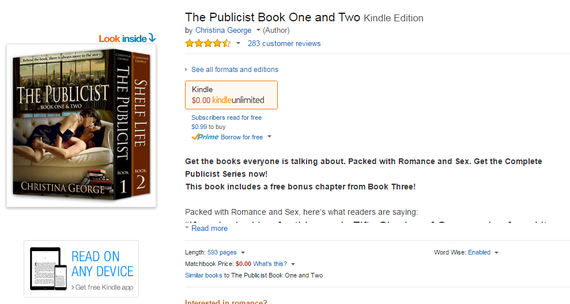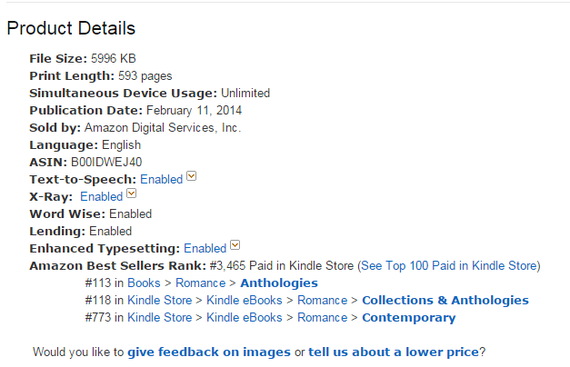When I was first in business, there were only 500 books published every day; now there are 4,500. I lead with this, not to start off this piece with buzzkill, but to remind all of us that hope is not a marketing plan. Surprisingly, marketing hasn't become more complex, though you'd think it would be, considering how much the competition has increased, right? Marketing may feel more complex, because you have more options and there's more to learn vis-a-vie social media, etc., but it really hasn't. What has changed, however, is the fact that in order to succeed, you must start with a strong strategy. At the end of the day, nothing else you do will matter if these pieces aren't in place.
I want to share some insights from a book we are working with, and actually the term "working with" is not entirely true. We have promoted the book, but the bulk of what I did with this was strategy. And while strategy may sound boring, putting the right pieces in place can really help you sell books. Have a look at the current sales rank on Amazon:
And also note the book is over a year old.
Want to know how we did it? Let me explain.
Though there are now five books in this series, The Publicist didn't start out that way. At the time, I thought it would be just one title, so with that in mind, we set to work on first creating a structure for the author.
Over the years, I've found that authors sometimes don't even think about setting up an instrastruture (i.e. their website or social media) until their book is out. This is a mistake that I liken to handing out fliers for your new store, but not deciding on its location until opening day. I think that a lot of authors feel that they only need to list their book on Amazon to sell the book, but really, there's so much more that must be done. You need to have an infrastructure in place to not only draw readers in, but engage with them as well. I have also heard the excuse "Let's see what the book does, before I go to all of this work." That, in and of itself, ensures a book's failure from the start. .
When I talk about infrastructure, I mean things like:
- Website: your website doesn't have to be big or complicated or expensive,ust something that shows off your book(s) in the best possible light.
Putting Your Book to Work
Your book won't sell itself, but if you put all of the right pieces in place, it just might. One of those pieces is a very thoughtful letter to readers. When it's not written in a pushy, sales format and includes a really genuine "thanks for reading" , this can go a long way. I put a letter to readers in every book I produce, and I recommended that the author do the same with The Publicist. We did this for the first book, and repeated the process when subsequent books came out. It not only worked brilliantly, but now, with several books in the series out, it continues to push readers from one book to the other.
Fans, Readers, and Super Fans
I talk a lot about the odds of getting the attention of bloggers for your first book; while you aren't getting intentionally ignored, it may often feel that way when you send a boatload of pitches, only to get one response. We love our bloggers, and we love our reviewers, but here's the thing: in an age where there are 4,500 books published each day, they're pretty busy. This is why you want to build fans and start building them early. Yes, you'll still want to pitch bloggers, but you want readers. I had an author tell me once that she didn't care what the average reader said about her book. This is a mistake, because the average reader can really help drive sales. Going one step further, the average super fan can not only drive sales, but also help spread the word about your book.
So how do you engage readers and turn fans into super fans? Well it takes a bit of work but it's worth it! When the book launches, start to get in touch with fans. Encourage them to write you by putting a thank you letter in the back of your book as I just mentioned. Be engaging with it, tell them you sincerely appreciate their time investing in your book, and now you'd like to hear from them. Getting a fan to contact you is golden. Once you have some fans writing you, you can start engaging more with them and encourage their dedication. Make them feel exclusive -- give them something to make them feel special. Maybe it's an early release of your next book or a special "behind the scenes" from your first one. We had an author who created a 'director's cut' of her book with deleted scenes, a behind the scenes diary and she included it all and gave it to fans, and guess what, they loved it! If fans are engaging with you already, the next step is to keep them talking, keep them active. This doesn't have to be a daily thing, but definitely a few times a month you want to reach out to them and build this relationship.
Free is Your Friend
A lot of authors dismiss free -- and in fact a lot of folks say that even now, free just does not work for them. If free isn't working for you, then you're doing it wrong. Free isn't something you just throw out there and hope for the best. You have to use it strategically -- like making the first book in your series free to drive readers to the other books. If you have a few books out, I recommend using free as a consistent tool and rotating books in and out of a day long freebie that you promote both to your readers and on social media.
Understand Amazon Algorithms
Amazon is a search engine. I write a lot about this both in my book How to Sell Books by the Truckload and on blogs. Here's the thing: most of us forget that you can get a lot of bounce for your book - for free - by working the internal algorithm. This means is focusing on your keyword strings (not single keywords, because consumers don't search that way). Where to start? Well, why not start by just plugging in the premise for your book into Amazon. Did you write a mystery thriller with an amateur sleuth as the protagonist? That's great *and* consumers do search that way, too. For example: murder mystery and amateur sleuth may get you a lot of great results. Is your book ranking for those keywords? If it's not it needs to be. For romance, you may have a romance about second chances or perhaps a Christmas romance. All of these are viable search possibilities. No consumer searches on just one keyword, so don't bother with just plugging in the term 'romance' into your string of keywords.
Reviews, Reviews, Reviews
It used to be that getting twenty reviews on Amazon was outstanding! Now, it's just a really modest start. As I mentioned in the Super Fans section, reviews aren't always the easiest thing to get, but it becomes a lot easier when fans become Super Fans. Don't hesitate to give or gift eBooks to eager readers who have agreed to offer an honest review of the book.
Reviews, incidentally, also trigger the Amazon algorithms, meaning they too help boost your book; if you have an older book, (like the one pictured in this piece) reviews and ongoing reviews are a great way to keep the title feeling "new," and to keep triggering Amazon for more exposure and also appeals to readers as well.
Rocking Out the Pre-Order
The pre-order feature on Amazon is a pretty cool way to feel like you're actually "launching" your book, instead of just putting it up on Amazon and having it go live right away. The thing is, if pre-order is used correctly, it can help boost a book for up to three months on Amazon. What do I mean by "boost"? It will keep the book at a very low sales rank (the lower the sales rank the higher the sales) with very little effort.
Here's how:
Keep your pre-order short -- no more than three weeks. You don't need a long pre-order on Amazon, because I have found that a long pre-order does not necessarily mean more sales; in fact, often the opposite is true.
Keep in mind that eBook pricing is a big deal to most consumers, so I recommend starting your book off with a lower price when it goes live, and keep it there for a week, maybe two. This will help keep you on the "new release" list even longer.
Get reviews for this pre-order, and get them up within 36-48 hours on Amazon. How you do this is with your Super Fans; give them a copy of the book in exchange for an honest review, and then incentivize them to review early. We did this for book three in The Publicist series and gave away tote bags to the first fifty reviewers who posted an honest review within 48 hours. Early reviews really help to drive sales, especially when a book is coming off of a pre-order. We also did it with book four, though we did a large portion of those reviews with our own stable of readers - timing them so their review dropped at the same time. If you don't have Super Fans and still want to do this, a solid marketing firm may be able to help you coordinate this.
Pricing strategy
There is a rumor going around that eBook sales are declining. This is actually not at all true. The reason this became an issue, was because traditional publishers were saying their sales are down. They are down, because they are pricing their eBooks too high. Consumers don't want to spend the same amount for an eBook as they do a print book, so be sure to price it less. In fact I've spoken to some folks at Kindle Direct Publishing who have said that they have found the sweet spot to be at $5.99.
For this book series, we play with pricing a lot. But it's not just for a series, I do the same thing whether I'm dealing with one book or several. Pricing matters to your consumer, so it should matter to you.
Write More:
Time was, you could put out one book, and wait around to see what happened. That time has long gone. Now you need to keep filling your virtual shelf space on Amazon. And if this sounds daunting, consider this: short is the new long. Not every book you publish has to be long - but it has to be quality. How short is short? Over 50 pages or 20,000 words is ideal. The more (quality) work you keep pushing out there, the more you'll start to "own" your virtual shelf space.
Follow What Works
The challenge with marketing a book these days is that while you have a huge number of great choices, , some may not be a right fit for your book. You won't know what's a right fit, until you have solid strategy in place that you can then weave new things into. Even then, not all of them will work, but at least you'll have laid the groundwork and a solid foundation to build off of, That's the key to success in the long term. Authors who launch a book with no framework, no idea of what they'll do next, and no marketing plan will most likely fail. Remember, hope is not a marketing plan. Plans, as you can see from this outline, don't have to be extensive or complicated, because really, complex marketing is not only hard to follow, but even harder to execute. What sells is the right kind of exposure.
You'll notice on here that nowhere did I say: Create a book trailer! Though we did create a few of them for this series, and they were great for added exposure, they didn't push the needle. You may find book trailers for you really do push the needle, but you won't know this until everything else is in place, and you can create a space where experimentation is possible.
When authors come to us I tell them that every campaign needs to be different, and this is very true, however every structure should be the same or similar. Think of it this way. When you're building a house, the house itself may look entirely different from your neighbor's home when it's done, but the foundation, walls, and roof all have similarities. A strong foundation is the thing that keeps you from turning a solid home into a house of cards.


